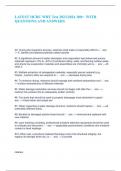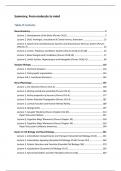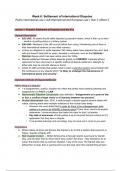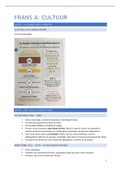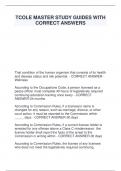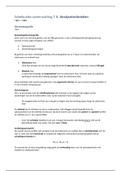BEA 2010 Managerial Accounting
Seminar Costing Systems: Traditional and Activity-based Costing - Solutions
5-1 In a traditional, volume-based product-costing system, only a single predetermined
overhead rate is used. All manufacturing-overhead costs are combined into one cost
pool, and they are applied to products on the basis of a single cost driver that is close-
ly related to production volume. The most frequently used cost drivers in traditional
product-costing systems are direct-labor hours, direct-labor dollars, machine hours,
and units of production.
5-3 An activity-based costing system is a two-stage process of assigning costs to products.
In stage one, activity-cost pools are established. In stage two a cost driver is identified
for each activity-cost pool. Then the costs in each pool are assigned to each product
line in proportion to the amount of the cost driver consumed by each product line.
5-4 A cost driver is a characteristic of an event or activity that results in the incurrence of
costs by that event or activity. In activity-based costing systems, the most significant
cost drivers are identified. Then a database is created that shows how these cost driv-
ers are distributed across products. This database is used to assign costs to the various
products depending on the extent to which they use each cost driver.
5-5 The four broad categories of activities identified in an activity-based costing system
are as follows:
(a) Unit-level activities: Must be done for each unit of production.
(b) Batch-level activities: Must be performed for each batch of products.
(c) Product-sustaining activities: Needed to support an entire product line.
(d) Facility-level (or general-operations-level) activities: Required for the entire
production process to occur.
5-7 Product-costing systems based on a single, volume-based cost driver tend to overcost
high-volume products, because all overhead costs are combined into one pool and dis-
tributed across all products on the basis of only one cost driver. This simple averaging
process fails to recognize the fact that a disproportionate amount of costs often is as-
sociated with low-volume or complex products. The result is that low-volume prod-
ucts are assigned less than their share of manufacturing costs, and high-volume prod-
ucts are assigned more than their share of the costs.
5-10 Two factors that tend to result in product cost distortion under traditional, volume-
based product-costing systems are as follows:
1
, (a) Non-unit level overhead costs: Many overhead costs vary with cost drivers that
are not unit-level activities. Use of a unit-level cost driver to assign such costs
tends to result in cost distortion.
(b) Product diversity: When a manufacturer produces a diverse set of products, which
exhibit different consumption ratios for overhead activities, use of a single cost
driver to assign costs results in cost distortion.
5-11 Three important factors in selecting cost drivers for an ABC system are as follows:
(a) Degree of correlation between consumption of an activity and consumption of the
cost driver.
(b) Cost of measurement of the cost driver.
(c) Behavioral effects, that is, how the cost driver selected will affect the behavior of
the individuals involved in the activity related to the cost driver.
PROBLEM 5-54
1. Activity Cost Pool Type of Activity
I: Machine-related costs Unit-level
II: Setup and inspection Batch-level
III: Engineering Product-sustaining-level
IV: Plant-related costs Facility-level
2. Calculation of pool rates:
I: Machine-related costs:
$1,800,000
= $100 per machine hr.
18,000 machine hrs.
II. Setup and inspection:
$720,000
= $9,000 per run
80 runs
III. Engineering:
$360,000
= $1,800 per change order
200 change orders
2
Seminar Costing Systems: Traditional and Activity-based Costing - Solutions
5-1 In a traditional, volume-based product-costing system, only a single predetermined
overhead rate is used. All manufacturing-overhead costs are combined into one cost
pool, and they are applied to products on the basis of a single cost driver that is close-
ly related to production volume. The most frequently used cost drivers in traditional
product-costing systems are direct-labor hours, direct-labor dollars, machine hours,
and units of production.
5-3 An activity-based costing system is a two-stage process of assigning costs to products.
In stage one, activity-cost pools are established. In stage two a cost driver is identified
for each activity-cost pool. Then the costs in each pool are assigned to each product
line in proportion to the amount of the cost driver consumed by each product line.
5-4 A cost driver is a characteristic of an event or activity that results in the incurrence of
costs by that event or activity. In activity-based costing systems, the most significant
cost drivers are identified. Then a database is created that shows how these cost driv-
ers are distributed across products. This database is used to assign costs to the various
products depending on the extent to which they use each cost driver.
5-5 The four broad categories of activities identified in an activity-based costing system
are as follows:
(a) Unit-level activities: Must be done for each unit of production.
(b) Batch-level activities: Must be performed for each batch of products.
(c) Product-sustaining activities: Needed to support an entire product line.
(d) Facility-level (or general-operations-level) activities: Required for the entire
production process to occur.
5-7 Product-costing systems based on a single, volume-based cost driver tend to overcost
high-volume products, because all overhead costs are combined into one pool and dis-
tributed across all products on the basis of only one cost driver. This simple averaging
process fails to recognize the fact that a disproportionate amount of costs often is as-
sociated with low-volume or complex products. The result is that low-volume prod-
ucts are assigned less than their share of manufacturing costs, and high-volume prod-
ucts are assigned more than their share of the costs.
5-10 Two factors that tend to result in product cost distortion under traditional, volume-
based product-costing systems are as follows:
1
, (a) Non-unit level overhead costs: Many overhead costs vary with cost drivers that
are not unit-level activities. Use of a unit-level cost driver to assign such costs
tends to result in cost distortion.
(b) Product diversity: When a manufacturer produces a diverse set of products, which
exhibit different consumption ratios for overhead activities, use of a single cost
driver to assign costs results in cost distortion.
5-11 Three important factors in selecting cost drivers for an ABC system are as follows:
(a) Degree of correlation between consumption of an activity and consumption of the
cost driver.
(b) Cost of measurement of the cost driver.
(c) Behavioral effects, that is, how the cost driver selected will affect the behavior of
the individuals involved in the activity related to the cost driver.
PROBLEM 5-54
1. Activity Cost Pool Type of Activity
I: Machine-related costs Unit-level
II: Setup and inspection Batch-level
III: Engineering Product-sustaining-level
IV: Plant-related costs Facility-level
2. Calculation of pool rates:
I: Machine-related costs:
$1,800,000
= $100 per machine hr.
18,000 machine hrs.
II. Setup and inspection:
$720,000
= $9,000 per run
80 runs
III. Engineering:
$360,000
= $1,800 per change order
200 change orders
2

